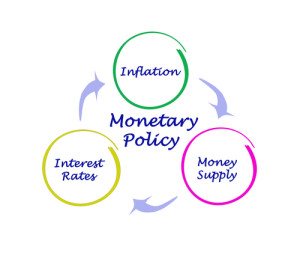Central Banks are government agencies that regulate their national currencies in order to maintain a healthy economic environment, balance exports and imports, prevent inflation, and stimulate growth within their economies. Central banks have a direct impact on the financial markets, and in particular the foreign exchange markets. The Central Bank is responsible for keeping their domestic economic affairs in order, while remaining competitive in the global environment.
Setting Lending Rates
One of the primary functions of a Central Bank is to facilitate lending within its state or region. As such Central Banks provide the necessary capital to various commercial banks. This lending arrangement between the central bank the commercial banks allows for an efficient access of capital for individuals and businesses. The rate at which this type of lending arrangement occurs is often referred to as the discount rate. The discount rate is the base rate set by the central bank from which other types of lending rates are calculated. This has a direct effect on the cost of funds to the end borrower.
These loans from the Central bank to the commercial banks helps ensure that the banking system has the necessary liquidity for ongoing credit relationships between the commercial banks and the citizens. Central banks have the responsibility of keeping the economy within their respective countries going. They will decrease interest rates at times when they would like to stimulate the economy and also they can increase interest rates at times when they would like to address inflationary concerns.
Setting Monetary Policy
The role of central banks extends to setting monetary policy for their particular country. Monetary Policy is defined as the actions taken by a central bank to regulate the supply of its currency.
Central banks also hold currency deposits as a form of asset and these reserves indicate the viability of a nation to pay for its foreign debts, and contributes to its overall sovereign credit rating. In the past, when the gold standard was in place, reserves were held in gold, but these days, it is held as actual currencies. As you may imagine, the US dollar, Euro, Swiss Franc, and Japanese Yen are some of the most widely held currency reverses by sovereign nations.
It is the responsibility of central banks to keep their economy moving in a sustained, yet stable fashion, and as such they must regulate the supply of money thru monetary policy. The primary means by which the Central Bank preforms this is thru intervention and open market transactions. Thru these open market transactions, the Central bank acts to promote economic growth while trying to curb any inflationary effects.
And so these activities by the Central bank leads to exchange rate changes. There are also times when Central Banks from several countries may come together to provide for liquidity across borders. Most times, however, the monetary policies for most developed countries relate to cause and effect surrounding their own economy.
It’s usually during times of economic stagnation, or financial crisis, that central Banks consider taking action to reduce interest rates, and make large scale asset purchases. Though this doesn’t always work, the idea behind this is that when the monetary base increases, there will be more currency available for banks and institutions that would lead to increased lending and credit, which in turn would lead to higher rates of growth within a country.
Now on the other hand, when there is fear of an inflationary environment, usually after a prolonged period of economic growth, the Central banks may step in and take contractionary measures. This usually comes in the form of higher interest rate decisions.
As interest rates rise, money becomes more scarce, and the credit environment begins to shrink. Businesses and individuals will find it harder to get financing or at least there is a premium placed on the financing. This causes the economy to slow and as such puts some controls on an inflationary environment.
As a forex trader, it is important to keep a watchful eye on upcoming economic releases and speeches from Central Banks. A good economic calendar is vital for all traders, regardless of whether you are trading using fundamental analysis or technical chart analysis. It’s obvious why a fundamental trader would want to keep abreast all Central Bank news, but even the technical trader could benefit from knowing what the major Central Banks are doing. 
Monetary Policy Example
To illustrate this with an example, let’s take a look at the Bank of Japan and some actions that they take in order to remain competitive in global trade. The Bank of Japan trys to keep the value of their currency, the Japanese Yen low, so as to promote their exports throughout the world.
By maintaining a weak Yen, the Japanese government, can ensure that their exports remain attractive to those around the world, and as such the products produced in Japan helps keep the Japanese economy moving forward.
And since the Japanese economy is highly dependent on exports, any strength in the yen would yield lower demand from Japanese manufacturers, which would result in reduced levels of growth within the Japanese economy. This in turn could lead to a recession, and higher unemployment rates. This is an example of why Central Bank policy and the actions that it takes is so crucial to the financial stability of a country.
Lender of Last Resort
During times of financial crisis, the central bank can act as a lender of last resort. When the commercial banks are unable or unwilling to provide loans, the central bank may step up to provide liquidity in order to avoid a potential shutdown of the economy. Essentially, the Central Bank will act to prevent a collapse of the banking system in their country. There are many legal and ethical concerns regarding this.
Many citizens feel that the Central Bank should not act as savior to failed commercial banking and Big Business policies that have led to recent financial crisis here in the United States and Globally. That is a subject for another day altogether. However, there is no doubt that, regardless of the legal or moral objections that many citizens may have to these interventions, it is clear that Central Banks must and will do whatever is required to ensure the stability of their respective countries economy.
The Major Central Banks around the World
U.S Federal Reserve ( The Fed )
More than 85% of all currency transactions are done with the US dollar. There is no doubt that the US dollar is the most highly traded currency in the world. The Federal Reserve is considered to be the most influential central bank in the world. And interest rate changes made by the U.S. Federal Reserve have a significant impact on other currencies around the world.
The Federal Reserve has a division within it, namely the Federal Open Market Committee (FOMC which is responsible for making interest rate decisions. The FOMC meets eight times per year. And as you can imagine, the decisions made by the FOMC are closely monitored by investors and traders both inside and outside the United States.
Bank of England (BOE)
The Bank of England is considered by many as one of the most capable central banks. The primary goal of the BOE is to maintain monetary and financial stability. The BOE aims to keep inflation at a 2% target per year. Any deviation from that, and they take measures to reach that target. The Bank of England’s Central Bank has a committee named the Monetary Policy committee with is responsible for setting monetary policy. The Monetary Policy Committee consists of 9 total members.
European Central Bank (ECB)
 The European Central Bank was organized after the creation of the EURO in 1998. The role of the ECB is to decide on monetary policy and provide price stability. The committee which is primarily responsible for this is known as the Governing Council.
The European Central Bank was organized after the creation of the EURO in 1998. The role of the ECB is to decide on monetary policy and provide price stability. The committee which is primarily responsible for this is known as the Governing Council.
The Governing Council is made up of 6 members of the board of the ECB and includes all the governors of the national central banks of the countries that comprise the European Union. The ECB meets several times per month, however, it only makes policy changes at 11 of these scheduled meeting times.
Swiss National Bank (SNB)
The Swiss Bank has a relatively small monetary committee consisting of 3 key individuals. The SNB is known to be conservative as far as interest rate decisions go. The Swiss National Bank’s Monetary committee meets quarterly. As of this writing, the key person within the committee is Jean-Pierre Roth, the Chairman of the SNB.
Bank of Japan (BOJ)
The monetary policy committee of the Bank of Japan is made up of the BOJ governor, two deputy governors and 6 other members. Since Japan’s economy is highly dependent on exports, one of the major concerns of the BOJ committee is to ensure a relatively weak Yen. The BOJ is quite active in the Open Market to ensure this goal. The Bank of Japan typically meets once or twice a month.
Bank of Canada (BOC)
The Bank of Canada’s monetary committee responsible for rate decisions is known as the Governing Council. It consists of the governor of the Bank of Canada, a senior deputy Governor, and four deputy governors. The BOC has set an inflation target of 1-3% per year, and thus far has been successful in meeting that goal over the last 15 years.
Reserve Bank of Australia (RBA)
The Central Bank known as the RBA has a monetary policy committee comprising of the RBA Governor, a deputy governor, a secretary to the Treasury, and six other members that have been appointed by the Australian government. The RBA has an inflation target rate of 2-3% per year. The committee meets eleven times per year to discuss and make monetary policy decisions.
Reserve Bank of New Zealand (RBNZ)
The Reserve Bank of New Zealand’s monetary policy decisions rests in the hands of the Central Bank Governor. Unlike other Central Banks that we have discussed, the RBNZ does not have a formal monetary policy committee. Instead the Governor has exclusive power of monetary policy decisions. The RBNZ has an inflation target of 1.5% per year, and the current governor Alan Bollard, is responsible for meeting that objective.
Understanding the goals of the main central banks around the world, helps traders gauge long term price movements of a currency. Knowing what the inflation targets are of each Central Bank, and where current inflation rates are in those countries, will provide valuable insight into potential price moves. One of the key measures of inflation is the Consumer Price Index, and so this is an economic indicator that both fundamental and technical traders should keep a close eye on.
Conclusion
As we have discussed in this article, the Central Banks play a key role in the economic health of their respective countries. They have many roles including setting lending rates, overseeing the monetary system, and ensuring global competitiveness. The Central banks play a pivotal role in controlling interest rates, inflation, and the overall supply of their currency.
The Central Banks have many tools at the disposal to ensure their end goals are met, including Open market participation and interventions. The decisions that the Central Banks make has widespread effects, and thus is it paramount that all traders pay close attention to the actions that they take.